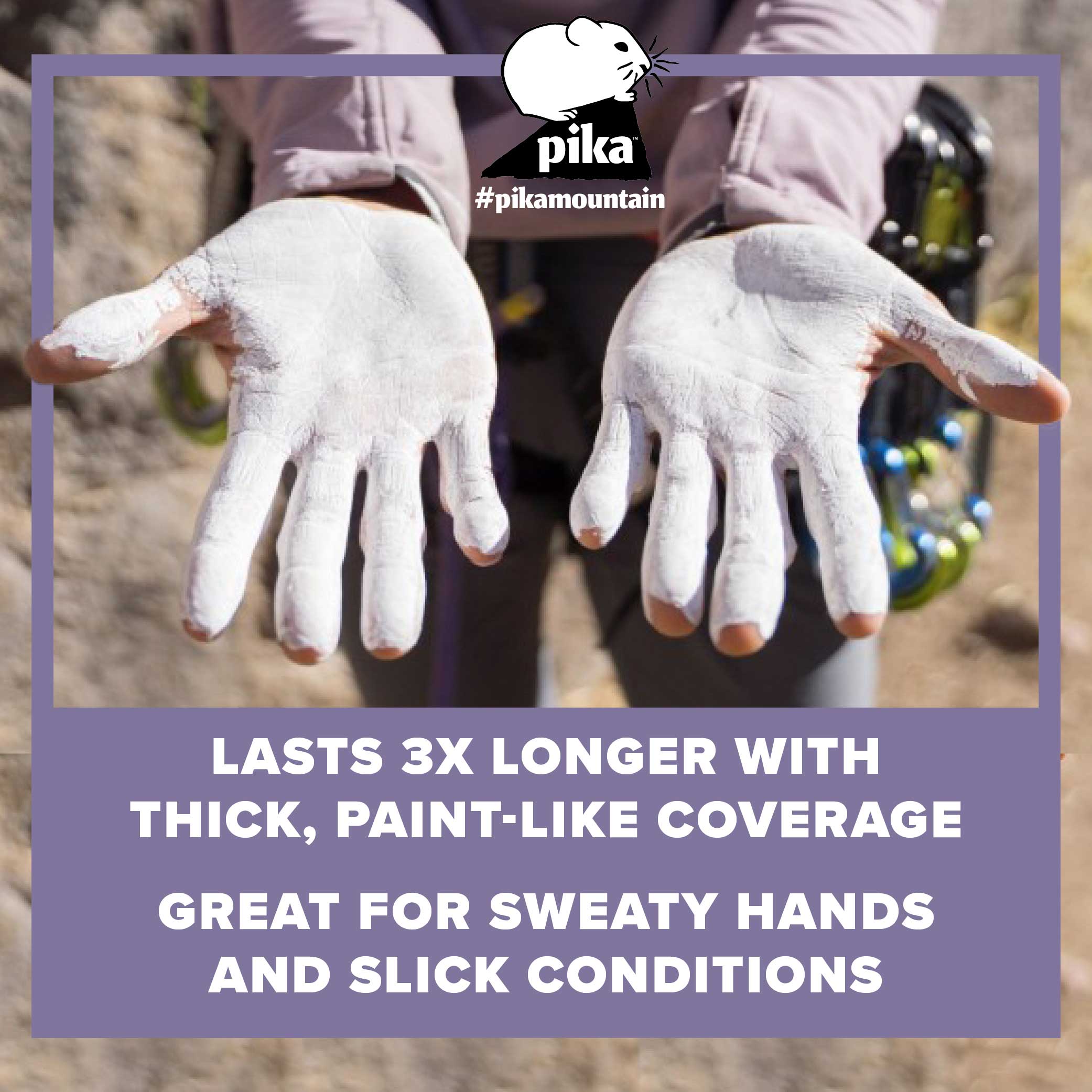As a tribute to Mother Earth this Earth Day, I wanted to take a moment to address some of the detrimental effects climbing chalk has on the environment and what we can do about it.
Rock climbing chalk is one of the least expensive and most overlooked pieces of equipment in our climbing gear setup. However, its environmental impact can be one of the biggest of all our gear.
How is chalk mined?
Let’s start at the beginning, with an explanation of how chalk is made and why it’s relevant. Powdered chalk is made from magnesium carbonate, which is extracted from the mineral dolomite.
The extraction process starts with powerful water jets blasting away at the rock and extracting the dust. The ore is then ground into powder and applied to a liquid slurry for drying, but this cools the slurry too much, reducing the number of particles it can hold, resulting in several larger pieces remaining in the finished product (the powdered chalk). Centrifuges or filters are then used to isolate the crystals. They’re then crushed into pieces or sold as granules at the end.
In areas of heavy dolomite mining, a lot of magnesium particles end up in the air and coat the surrounding countryside. The environment suffers from contamination and habitat loss. This can lead to an overall negative impact on both plants and animals that rely heavily upon these environments for survival.
How much chalk do rock climbers use?
It’s hard to say exactly, but we can make an educated guess. There are around 25M rock climbers globally. I personally use three to four 16 ounce bags of chalk per year (much less now that I’ve switched to liquid chalk, but we’ll get into that later).
Assuming most people don’t climb as often as me, let’s say that climbers average two bags of chalk per year. That means we collectively go through 50,000,000 pounds, or 25,000 tons, of chalk every single year, and that doesn’t include the chalk used by weightlifters, gymnasts, and other athletes. Even if my estimates are off a bit, it’s still a lot of chalk.
How does powdered chalk negatively impact rock formations?
There are several ways loose chalk can pose a threat to our environment. Individually, they’re cause for concern but hardly warrant outrage. However, when you add them all together and multiply by 25M climbers today and add the quickly growing number of climbers in the world, it’s easy to see how we could have a full-blown crisis on our hands in the not-so-distant future.
Permanent graffiti on our natural landmarks
It’s no secret that powdered or loose chalk leaves visible residue on the rock formations. While we like to think that mother nature will simply wash off the chalk with the next rainstorm, that’s not the case. Chalk stays on the wall like graffiti, especially in arid regions, on overhung cliff faces, and on porous types of rock.
In many places, chalk will never come off unless it is wiped or brushed off, which, let’s face it, is a rare occurrence. Furthermore, chalk accumulates on holds over time, so that common routes can become so polished that they’re effectively unclimbable or at minimum forever changed. We’ve all seen even worse examples of humans defacing nature, but we’re naive to believe our chalk use is completely blameless on this front.
This is one of the main reasons popular climbing spots like the Shawangunks in New York, are starting to ban powdered chalk and only allow liquid chalk. In fact, just last month the heavily trafficked Garden of the Gods in Colorado banned chalk completely. It’s only a matter of time before other climbing areas ban chalk too.
Micro spills that cause macro problems
Mine contamination is unquestionably much worse than what we do to our local crags. However, I can’t count the number of times my own chalk bucket or bag has been dropped, knocked over, or landed on, dumping a small pile of chalk in the dirt and weeds. I’m sure it happens to someone every day at busy climbing areas.
There’s not much, if any, research that focuses precisely on these kinds of chalk micro-spills. However, it’s possible, perhaps probable, that the soils and microhabitats under and around those small chalk spills are negatively impacted in similar ways to how the soils and ecosystems are impacted by nearby chalk mines.
Destruction of local flora and fauna
Climbing chalk likely alters the pH and nutrient conditions on rocks, which may affect rock‐dwelling organisms. In one study that sought to measure the impact of chalk on rock-dwelling plants, researchers discovered elevated climbing chalk levels on 65% of sampling points without any visual traces of climbing chalk. In other words, damage is being done even when no visible traces of chalk are evident.
In a study published by Ecology and Evolution, researchers measured the potential impact on four ferns and four moss species in an experimental setup in a climate chamber.
The experiment revealed that elevated climbing chalk concentrations had a substantial negative impact on the germination and longevity of both ferns and mosses, though the results were varying.
Although there may be disputes among scientists about how much damage is being done, it is generally acknowledged that our flora and fauna are being harmed.
What can we do to lessen our impact on the environment?
Climbing is a great way to get outside, stay in shape, and make new friends. If we take a few simple steps to reduce our environmental impact, it can be a far more guilt-free practice. Since we’re focusing on chalk, here are a few simple tweaks to your routine which can help preserve the landmarks we love.
Learn to use less chalk
While one of the simplest changes you can make, it’s also one of the hardest. Chalking up is often a nervous habit and quickly becomes an automatic ritual. Resisting the urge to chalk up three times before starting each climb and every 30 seconds thereafter is a hard habit to break.
In principle, reducing our use of chalk will help, but doing so in practice is difficult. Particularly when your hands are sticky with sweat, you’re halfway up a trail, and you’re clinging to a small crag or a slippery sloper. Dip back into the chalk bag for a fast rechalk before crushing the crux step and sending the rest of the route is reassuring. We can always try wiping the sweat off our hands onto a small towel or our clothes, but that often doesn’t fully solve the problem.
Wipe down routes or use colored chalk to match rocks
Colored chalk can reduce the graffiti of white holds and tick marks left behind on popular routes, but that’s about the only benefit over regular chalk. Still, some national parks prohibit chalk that doesn’t match the color of the local rock, so it may be worth considering.
If you’re feeling ambitious and have plenty of time on your hands, you can also brush off and wipe down any chalk you leave behind as you go.
Use liquid chalk
Liquid chalk isn’t a perfect solution, but it’s a great alternative. Liquid chalk is just chalk in a creamy consistency, in case you’re not familiar with it. Magnesium carbonate and alcohol are typically the main two ingredients, plus various other natural and/or synthetic ingredients.
You spread a tiny dollop over your palms, wait a few seconds for the alcohol to dry, and you’re chalked up and ready to climb for much longer than if you used loose chalk or a chalk ball.
You need to avoid liquid chalks that contain pine rosin (AKA pine resin, pine tar, pitch, sap, and colophony). Pine rosin is extremely sticky, which can be useful for gripping slippery surfaces, but it gums up climbing holds badly. Because it’s not water-soluble, it won’t wash away in the rain, and thus it can destroy routes forever.
How can we as climbers do better?
As rock climbers love our sport, we love our gear, and we love our chalk. Let’s make sure we show some love to our planet too.
By simply being more mindful of our choices when it comes to climbing chalk we can preserve our natural landmarks for generations to come. If you’re feeling inclined to make a change in your gear this Earth Day, perhaps give our Pika Scented Liquid Chalk a try.
Our unique, zero-slip liquid chalk formula is extra-grippy and stays on your hands a very long time. It doesn’t easily rub off on holds or fall off to the ground. You’ll chalk up less frequently than you would by using other liquid chalks and ultimately use a lot less chalk overall.
Additionally, Pika uses organic ingredients whenever possible. We also use extremely pure, high-grade magnesium carbonate. Our high-quality and organic ingredients and 100% compostable packaging makes our products safer for our customers, our employees, and the environment.

